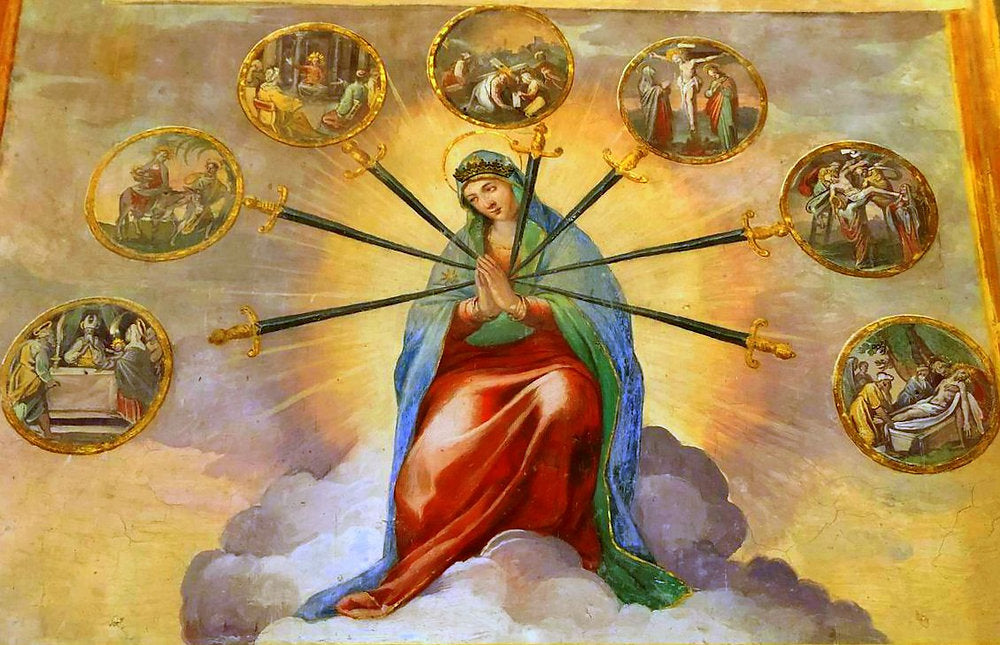
Feast of the Seven Sorrows of the Blessed Virgin Mary
The feast began to be celebrated in the West during the Middle Ages and at that time there was talk of the "Transfixion of Mary", of the "Recommendation of Mary on Calvary", and it was commemorated at Easter time.
In the twelfth century, the Servite religious celebrated the memory of Mary under the Cross with an office and a special Mass. Later, in the seventeenth century, it was celebrated on the third Sunday of September.
On the Friday before Palm Sunday, there was also a commemoration of the Sorrowful Virgin, a festivity popularly known as "Friday of Sorrows".
Benedict XIII universally extended the celebration of the "Friday of Sorrows" in 1472 and in 1814 Pope Pius VII set the Feast of Our Lady of Sorrows for September 15, a day after the Exaltation of the Holy Cross.
What was Simeon's prophecy?
God never left His people devoid of prophets, individuals like the aged Simeon whose prophecy involving Mary is recounted in Luke's Gospel (Lk 2:25-35):
Why is Mary depicted with a sword in her heart?
Simeon told the Blessed Mother that a sword would pierce his soul (Lk 2:35). This points to the pains that Mary was going to suffer for accompanying the redemptive mission of her Son.
What are the seven sorrows that pierced Mary's heart?
- Simeon's prophecy (Luke 2:25-35)
- The Flight into Egypt (Matthew 2:13-15)
- Jesus is lost for three days (Luke 2:41-50)
- Mary encounters Jesus on the road to Calvary (Luke 23:27-31; John 19:17)
- Crucifixion and Death of Jesus (John 19:25-30)
- The body of Jesus is taken down from the Cross (Ps 130; Luke 23:50-54; John 19:31-37)
- The burial of Jesus (Isaiah 53:8; Luke 23:50-56; John 19:38-42; Mark 15:40-47)
"This poor Mother had to see how her Son, so kind and so loved, was unjustly snatched from her arms in the fullness of His life and subjected to a barbarous death... The immense torment that Mary lived for us – more painful than a thousand deaths – deserves our compassion and our gratitude." – St. Alphonsus Liguori
ORIGIN
- Friday before Palm Sunday, major double;
- Third Sunday in September double of the second class.
The object of these feasts is the spiritual martyrdom of the Mother of God and her compassion with the sufferings of her Divine Son.
(1) The seven founders of the Servite Order, in 1239, five years after they established themselves on Monte Senario, took up the sorrows of Mary, standing under the Cross, as the principal devotion of their order. The corresponding feast, however, did not originate with them; its celebration was enacted by a provincial synod of Cologne (1413) to expiate the crimes of the iconoclast Hussites; it was to be kept on the Friday after the third Sunday after Easter under the title: "Commemoratio augustix et doloris B. Marix V.". Its object was exclusively the sorrow of Mary during the Crucifixion and Death of Christ. Before the sixteenth century this feast was limited to the dioceses of North Germany, Scandinavia, and Scotland. Being termed "Compassio" or "Transfixio", "Commendatio, Lamentatio B.M.V.", it was kept at a great variety of dates, mostly during Eastertide or shortly after Pentacost, or on some fixed day of a month (18 July, Merseburg; 19 July, Halberstadt, Lxbeck, Meissen; 20 July, Naumberg; cf. Grotefend, "Zeitrechnung", II, 2, 166). Dreves and Blume (Analecta hymnica) have published a large number of rhythmical offices, sequences and hymns for the feast of the Compassion, which show that from the end of the fifteenth century in several dioceses the scope of this feast was widened to commemorate either five dolours, from the imprisonment to the burial of Christ, or seven dolours, extending over the entire life of Mary (cf. XXIV, 122-53; VIII, 51 sq.; X, 79 sq., etc.). Towards the end of the end of the sixteenth century the feast spread over part of the south of Europe; in 1506 it was granted to the nuns of the Annunciation under the title "Spasmi B.M.V.", Monday after Passion Sunday; in 1600 to the Servite nuns of Valencia, "B.M.V. sub pede Crucis", Friday before Palm Sunday. After 1600 it became popular in France and was termed "Dominx N. de Pietate", Friday before Palm Sunday. To this latter date the feast was assigned for the whole German Empire (1674). By a Decree of 22 April 1727, Benedict XIII extended it to the entire Latin Church, under the title "Septem dolorum B.M.V.", although the Office and Mass retain the original character of the feast, the Compassion of Mary at the foot of the Cross. At both Mass and Office the "Stabat Mater" of Giacopone da Todi (1306) is sung.
(2) The second feast was granted to the Servites, 9 June and 15 September, 1668, double with an octave for the third Sunday in September. Its object of the seven dolours of Mary (according to the responsories of Matins: the sorrow
- at the prophecy of Simeon;
- at the flight into Egypt;
- having lost the Holy Child at Jerusalem;
- meeting Jesus on his way to Calvary;
- standing at the foot of the Cross;
- Jesus being taken from the Cross;
- at the burial of Christ.
This feast was extended to Spain (1735); to Tuscany (double of the second class with an octave, 1807). After his return from his exile in France Pius VII extended the feast to the Latin Church (18 September, 1814), major double); it was raised to the rank of a double of the second class, 13 May, 1908. The Servites celebrate it as a double of the first class with an octave and a vigil. Also in the Passionate Order, at Florence and Granada (N.S. de las Angustias), its rank is double of the first class with an octave. The hymns which are now used in the Office of this feast were probably composed by the Servite Callisto Palumbella (eighteenth century). On the devotion, cf. Kellner, "Heortology", p. 271. The old title of the "Compassio" is preserved by the Diocese of Hildesheim in a simple feast, Saturday after the octave of Corpus Christi. A feast, "B.M.V. de pietate", with a beautiful medieval office, is kept in honour of the sorrowful mother at Goa in India and Braga in Portugal, on the third Sunday of October; in the ecclesiastical province of Rio de Janeiro in Brazil, last Sunday of May, etc. (cf. the corresponding calendars). A special form of devotion is practiced in Spanish-speaking countries under the term of "N.S. de la Soledad", to commemorate the solitude of Mary on Holy Saturday. Its origin goes back to Queen Juana, lamenting the early death of her husband Philip I, King of Spain (1506).
To the oriental churches these feasts are unknown; the Catholic Ruthenians keep a feast of the sorrowful Mother on Friday after the octave of Corpus Christi.
About this page
APA citation. Holweck, F. (1912). Feasts of the Seven Sorrows of the Blessed Virgin Mary. In The Catholic Encyclopedia. New York: Robert Appleton Company. http://www.newadvent.org/cathen/14151b.htm
MLA citation. Holweck, Frederick. "Feasts of the Seven Sorrows of the Blessed Virgin Mary." The Catholic Encyclopedia. Vol. 14. New York: Robert Appleton Company, 1912. <http://www.newadvent.org/cathen/14151b.htm>
Prayer to Our Lady of Sorrows
Our Lady and Mother, you were serene and strong at the cross of Jesus. You offered your Son to the Father for the redemption of the world.
You lost it, in a sense, because He had to be in the Father's things, but you gained it because He became the Redeemer of the world, the Friend who lays down his life for his friends.
Mary, how beautiful it is to hear from the Cross the words of Jesus: "Behold, your son", "Behold, your Mother".
How good it would be if we receive you in our house like Juan! We want to always take you to our home. Our home is where we live. But our home is above all the heart, where the Blessed Trinity dwells. Amen.
With information from Vatican News and EWTN.
